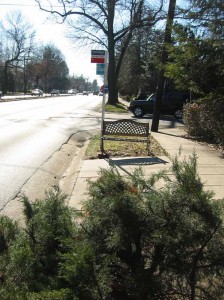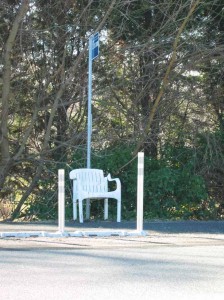Transportation planners talk about mode share, trip mitigation, and relative arterial mobility all displayed in charts and graphs. But there is a human element to using transit. Why would you shower, dress, and walk down the hill to stand here while your neighbors whip past in their BMWs, warm, dry, singing along to Norah Jones, and a swigging a latte?
Montgomery County has a great local bus system, the Ride Ons, which course through neighborhoods connecting to central business districts, Metro, and regional buses. They are clean, relatively prompt, and reasonably priced. Seniors and students get a price break, increasing access, and some of the fleet is running on compressed natural gas, encouraging good green behavior.
But in a County that is consistently measured as one of the country’s wealthiest, our bus stops are not that great and perhaps it’s because we are so wealthy. We drive to work while the buses are reserved for our kids and their babysitters.
But we also have some gumption. Communities around the County have, independently of MCDOT, tried to make bus stops more welcoming.




Casey Anderson
It’s not about the experience at the bus stop — it’s about the experience once you are actually on the bus, namely, watching your neighbors whip by in their bmws while you stop every few blocks to pick up and drop off passengers. without dedicated row, the bus has almost all of the downsides of taking your own car (except for cost) with none of the convenience, because you will be stuck in exactly the same traffic as cars but lack the flexibility (in scheduling and drop off/pick up points) that drivers enjoy. that’s why few people who have the means to drive will choose the bus — in contrast to rail, which attracts lots of people who could afford to drive but would rather not be stuck in traffic.
Bob
Other factors are the frequency of the buses and non-direct routes. I’ve taken Ride On, but I can walk to the metro station — about a mile from my home — in less time than I’d wait at the stop if I just missed a bus and then the bus goes “the long way around” so even if I caught the bus on time, I can walk to the station faster, not to mention at no cost. And when the weather is bad, I drive to the station. Waiting at a bus stop in bad weather is no better than walking to the metro station.
This may be politically incorrect, but I think the reality of the situation is that we are spending a lot of money subsidizing the bus system that could be better spent improving the road system; more people would benefit. We simply don’t have enough money to subsidize buses to the extent necessary to make them a desired alternative to driving for most people.
Paul Grenier
Bob and Casey are probably right. All the same, check out some of the innovative bus stops we’ve created on New Hampshire Ave. in Takoma Park. After all, if one DOES have to take the bus, you might as well make it feel more, well, cozy like. We’ve added brightly colored rocking chairs, reclining chairs (both of recycled plastic), and some high-design cast aluminum benches. They get used a lot, and it has a more human feel to it.
Not that we’ve reached bus stop nirvana. Far from it. A good bus stop experience has to be part of a context that transcends the bench, though that’s a start. I remember bus stops in Anzio (a pretty average town in Italy). Average looking bench, but a newspaper kiosk not far away, and a food stand, and a cafe, and all of this on a small square with a wide variety of architecture and stores and passersby to look at. I’d take the bus there any time. $%&* ! the BMW. But then that’s the real rub. We’ve allowed private luxury to substitute for an impoverished common realm.
David Rotenstein
I try to take the bus whenever possible. That said, the experience of using Ride On or Metrobus, is supremely depressing and a significant disincentive for me to keep the car parked. The buses in the morning and afternoon are seriously overcrowded and the only person I really want to be spooning early in the morning is my wife. In the afternoons, the juvenile delinquents on the buses make the rides a noisy and uncomfortable ride. The drivers do little to control the profanity, shoving, shouting, and other conduct better left to school buses or non-public spaces.
Jad
Funny to see my old stop at River & Braeburn leading the story. Stops like this between a highway and a ditch communicate to bus users that they are a (literally!) marginalized part of society, and that their comfort and perception of safety aren’t important. But as for our wmata/ride-on solutions – why is a simple garden bench or plastic chair always more comfortable than the bench in a bus enclosure?
Paul Grenier
In answer to Jad’s question: bus benches are generally designed to be uncomfortable, for fear that someone will otherwise sleep on them. An exaggerated fear, in my opinion (except in very specific locations). The other desirable characteristic is that they be indestructible, which also doesn’t make for comfort.
Not to change the subject, but does anyone else find incomprehensible the gobbledegook we are supposed to decipher so that we can assure the website that we are human?